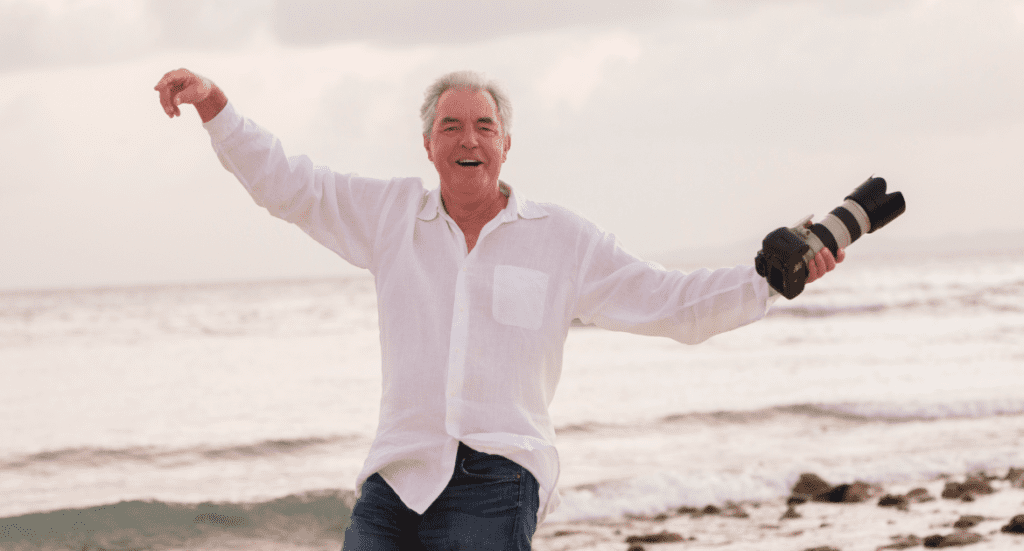Philip Bermingham: The Power of Photography
By • May 17, 2021 0 3069

Some of the people photographed by Philip Bermingham — Queen Elizabeth and Prince Philip with George H. W. and Barbara Bush, for instance — are figures known the world over. The ones he poses for covers of The Georgetowner tend to be prominent Georgetown residents or business owners. And then there are those … well, even he doesn’t know who they are. As Bermingham noted in a recent interview at his home in Watergate West, certain clients are “incredibly private.” For those commissions, he is “approached by a lawyer with a nondisclosure form.”

All Smiles for official photograph taken by Philip (l-r) HRH The Duke of Edinburgh, Her Majesty Queen Elizabeth II, President George H.W. Bush, First Lady Barbara Bush (Photograph copyright Philip Bermingham 2017)
In recognition of Bermingham’s work over the years for The Georgetowner, on the occasion of his 70th birthday (surprise!) — with his daughter’s wedding coming up, then service as a judge of our summer photography contest — we pay affectionate tribute to a true master of portraiture.
He has shot some 30 covers for The Georgetowner, describing its publisher Sonya Bernhardt as “quite a force.” (They met because of a story on Sarah Williams purses.) A book featuring a selection of his black-and-white and color portraits, including several of those cover images, will be published this September.
Bermingham began his career by training to become a Liverpool bobby. He still has a slight Beatles accent (and speaks Scouse with old friends, no doubt). Starting at age 15, he spent three years as a police cadet, then two on the regular force.
Of “unquestionable sobriety and single,” he proceeded to land one of 20 open spots for a five-year contract as a police officer in Bermuda. There were 800 applicants. “The salary was about two-and-a-half times what I was getting in Liverpool,” he explained.
Bermingham met his wife Ann, a nurse from Allentown, Pennsylvania, in Bermuda; they moved to Washington, D.C., late in 1978. Having made the transition from policeman to commercial photographer — it began with fingerprint and crime-scene photography — he decided to relocate to the nation’s capital since “anybody who’s anybody is going to go to D.C.” There were (and are) “such a variety of people,” he said, “lobbyists, politicians, diplomats … not like a bunch of lawyers and doctors.”
Back then, the boutique Smith’s of Bermuda had a store in Alexandria, Virginia. (A location in McLean, Virginia, recently closed.) Leveraging that connection, Bermingham showed his portfolio to the manager, “a very affable Scots guy,” who “bought about 25 large scenes of Bermuda and put them up in the store.” After doing “some photography sessions of the clothes,” he was permitted to set up a studio on the second floor of Smith’s, where his work was displayed to shoppers. “I was also bringing clients,” he pointed out, so it was “a win-win.”
In 1987, Bermingham bought a building in McLean. Why McLean? For one thing, “the families tended to be bigger in McLean.” For another, that studio drew not only from Alexandria but from Great Falls, Virginia, and Potomac, Maryland. Even better, the McLean clients “would order a 30-by-40 portrait,” larger than the typical Alexandria size. “Do the math,” he said.
The one person Bermingham counts as “the most influential” in his career development is Virginia Mars. He photographed her family and then went on to take portraits of almost every ambassador in Washington. Those VIPSs he can name include Richard Nixon, Charles and Camilla, Gen. Colin Powell, some rock-n-rollers and, most recently, our very own Mayor Muriel Bowser.
Bermingham maintained the McLean studio for 30 years, along the way relocating from Alexandria — his daughter Scarlett was “a lifer” at St. Stephen’s & St. Agnes School — to the Watergate.
Moving into Watergate South, where he first lived in the complex, required an interview with the board, represented by Ruth Bader Ginsburg’s husband Martin. The other candidate at the time was Plácido Domingo, then artistic director of Washington National Opera.
Bermingham later photographed the justice in her chambers, with his daughter, “a big RBG fan,” flying in from California to meet her. He didn’t photograph “Marty,” he said, “but I did see him a lot in the Safeway, because he would buy the food,” as the cook for the Ginsburg household.
The connection to Domingo bore fruit, too. Over 10 years, Bermingham photographed some 500 WNO singers, also going along on the company’s Japan tour in 2002.
Though he says, “I mentally rehearse every session,” Bermingham has found from long experience that “it never happens that way.” A portrait session relies on “sort of an unspoken tacit complicity” that sometimes isn’t there at the start. For example, Washington Speakers Bureau hired him to photograph George Will in his Georgetown office — and “George Will didn’t want to be photographed.” Luckily, Bermingham was able to “get him engaged in baseball and Margaret Thatcher.”
Connecting through conversation and eye contact is important to how he works. “You can watch people change,” he said. “They’re almost like a brick wall … you watch the hand movements.” And he enjoys the interaction: “There’s nothing more exciting than being in a portrait session. I have to come down after a session.”
Apart from portraiture, Bermingham is devoted to photographing the landscape of Biddeford Pool, Maine. The tiny seacoast community, between Kennebunkport and Portland, is within the Rachel Carson National Wildlife Refuge. After summering in Bermuda for years, he visited the area with a friend for the weekend and, captivated, ended up buying two cottages. Bermingham takes about 10,000 photographs in and around Biddeford Pool every summer. In June, his daughter will get married there. Though he has sold some large Maine landscape photographs, it’s “something you do for your soul,” he said.
After all these years, remarked the ex-cop from Liverpool: “I’ve never tired of photography, never said, ‘That’s enough.’ ”

